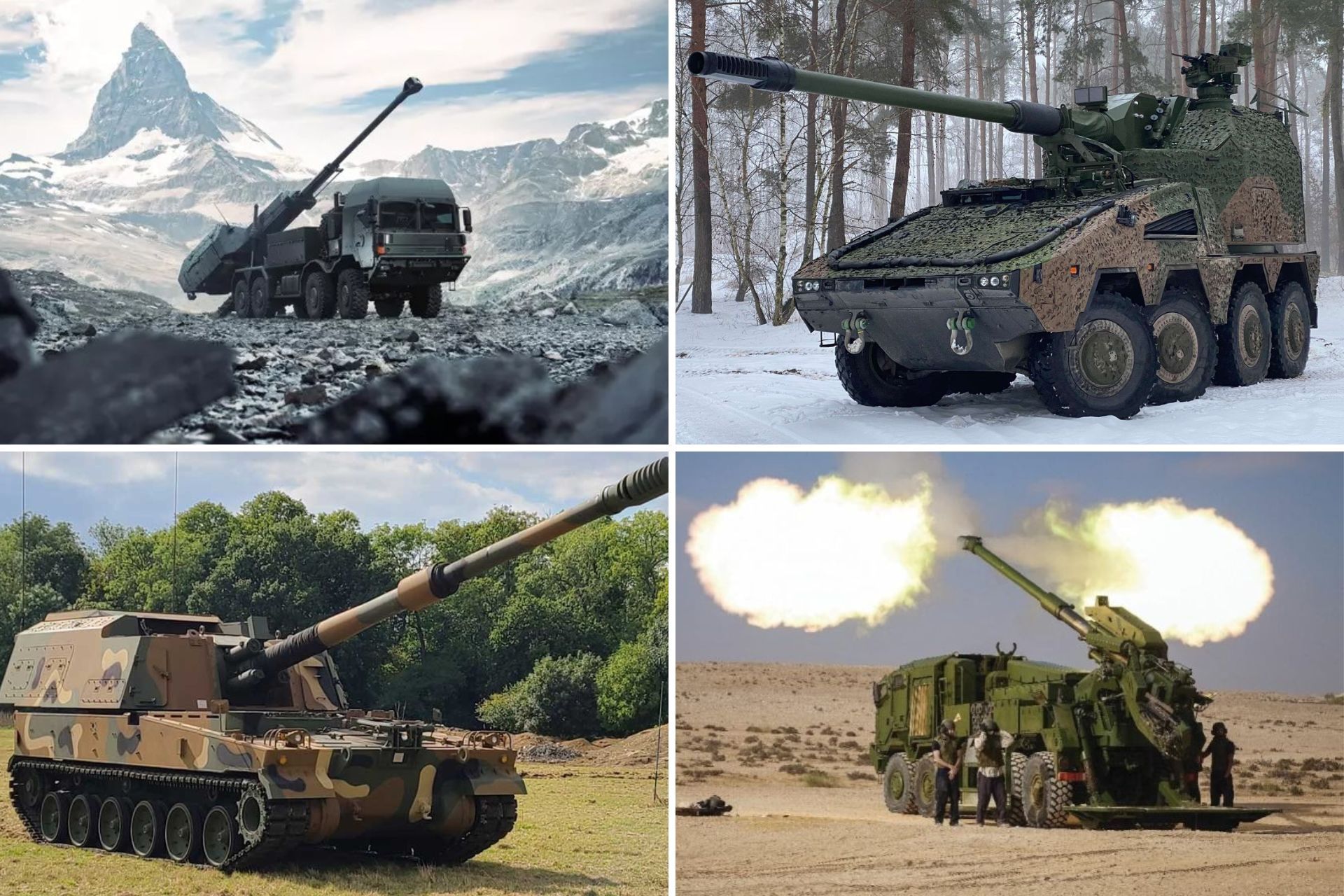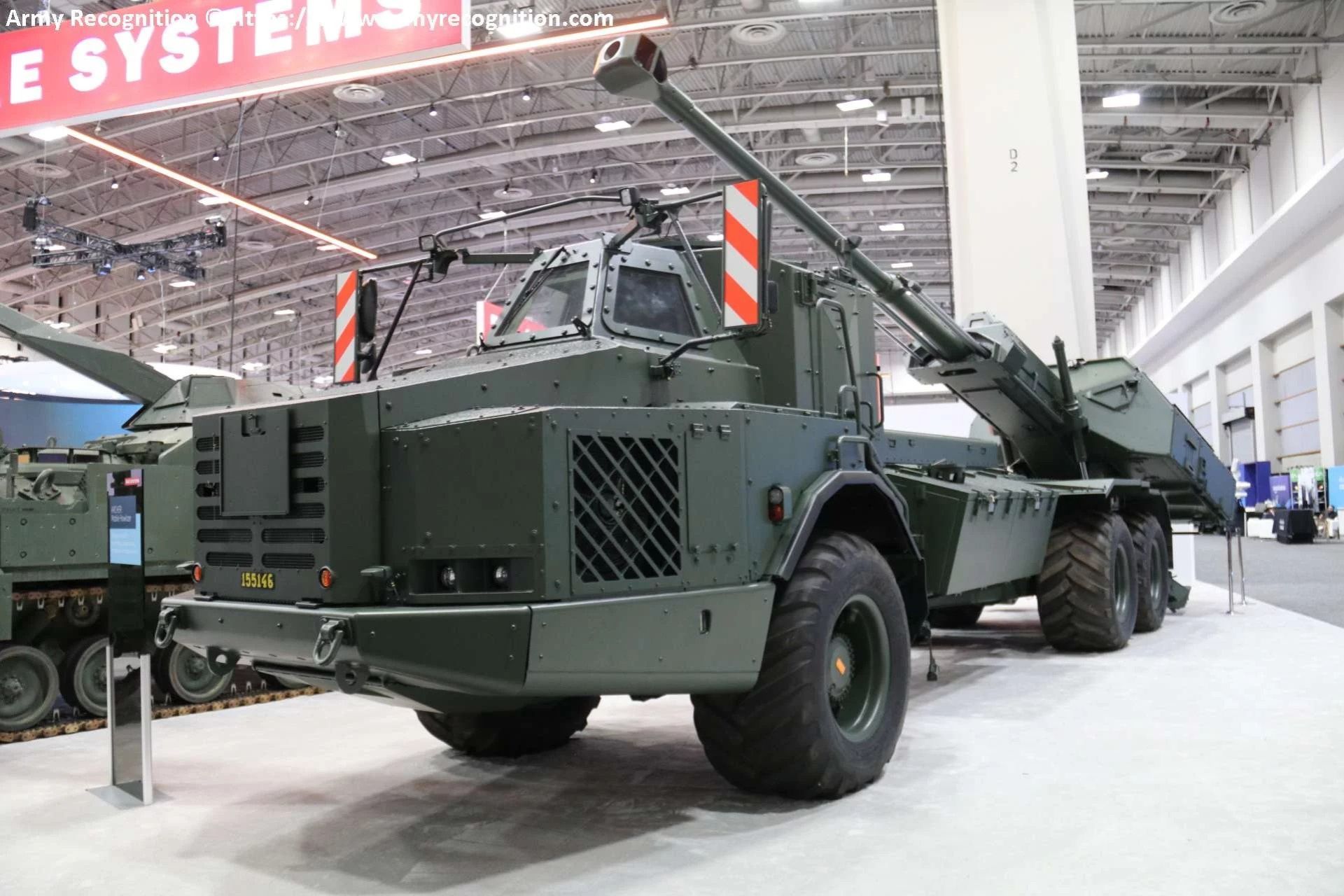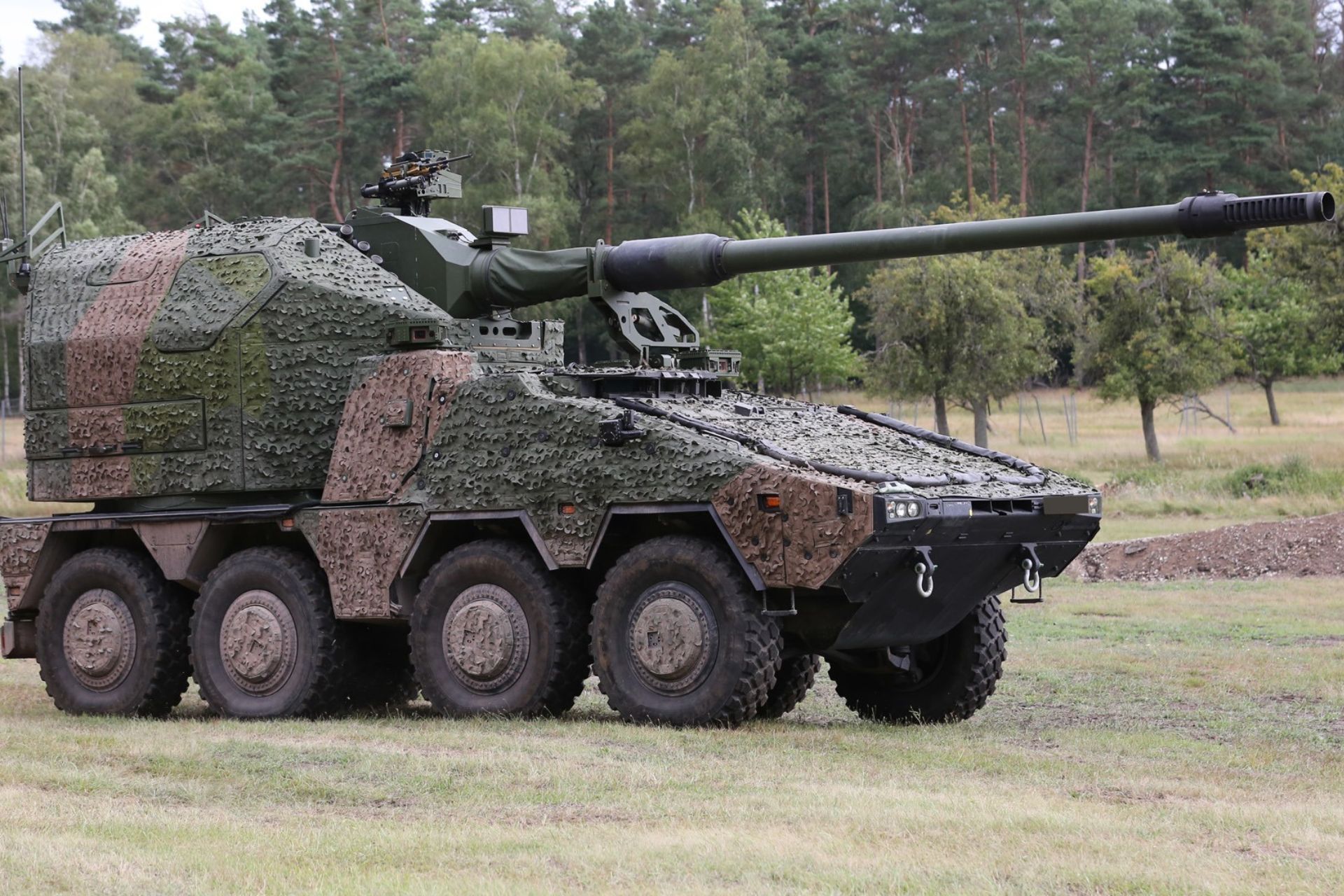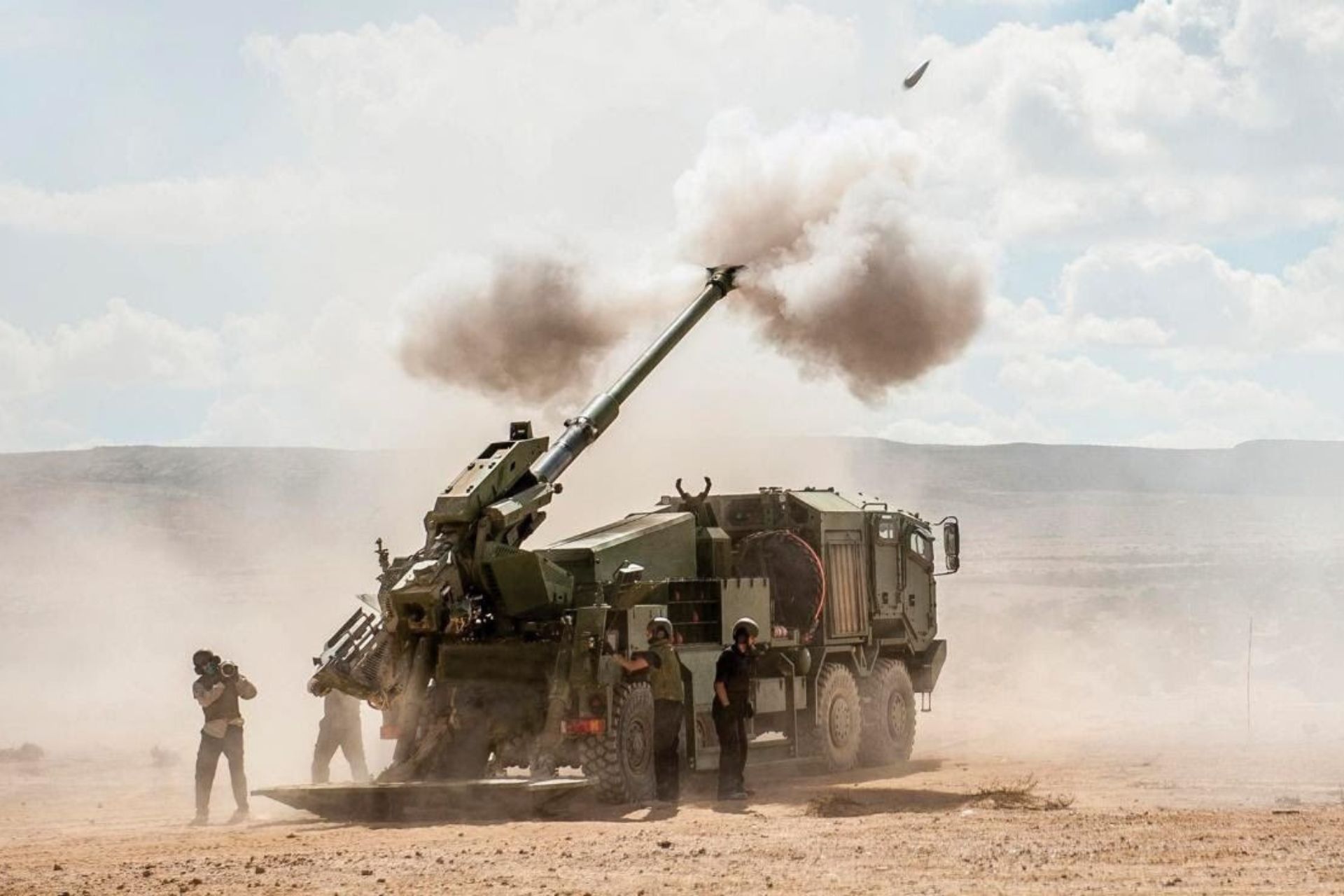Breaking News
US Army Could Select Its Next-Generation Self-Propelled Howitzer Abroad.
On October 15, 2024, the U.S. Army announced the awarding of five contracts for the upcoming performance demonstration for self-propelled howitzer modernization. The companies selected for these contracts include American Rheinmetall Vehicles, BAE BOFORS, Hanwha Defense USA, General Dynamics Land Systems, and Elbit Systems USA. These contracts, awarded under Other Transaction Agreements (OTAs), total approximately $4 million across all companies.

Performance demonstrations, set to begin in November 2024, will guide several SPH-M efforts outlined in the Army’s Cannon Transformation Strategy (Picture source: Hanwha Aerospace, Bae Systems, Rheinmetall and Elbit Systems)
The Self-Propelled Howitzer Modernization (SPH-M) initiative, previously known as the Extended Range Cannon Artillery (ERCA), aims to enhance howitzer lethality by increasing range and rate of fire, using mature technologies to boost mobility, survivability, reliability, logistics support, and firepower in self-propelled artillery systems.
In October 2023, the Army ended the ERCA rapid prototyping effort, determining that further development and redesign of the 58-caliber cannon were necessary before moving into an official acquisition phase. Major General Glenn Dean, Program Executive Officer for Ground Combat Systems, confirmed this decision and explained that, as part of the new strategy, the Army is exploring both U.S. and international options to leverage mature and available industrial solutions to fill critical capability gaps.
Performance demonstrations, set to begin in November 2024, will guide several SPH-M efforts outlined in the Army’s Cannon Transformation Strategy. According to General Dean, these demonstrations are intended to support the Army’s shift from development to procurement of a mature, available, and non-developmental system. The goal is to complete all vendor performance demonstrations by the end of 2024, allowing the Army to determine if operationally suitable solutions exist that may advance to a competitive evaluation stage, potentially leading to future production contracts.
Currently, the U.S. Army employs several howitzers to meet diverse operational needs. The M109A7 Paladin, a 155 mm self-propelled howitzer, offers significant mobility and precision, especially with Excalibur-guided munitions. The M777, a 155 mm towed howitzer, is lightweight and deployable by helicopter, while the 105 mm M119A3 is used for close-range support in challenging terrain. Although gradually replaced, the 155 mm M198 remains a reliable howitzer for reserve units. These systems provide the Army with a broad range of capabilities in range, mobility, and firepower.

The K9A2 features a fully automatic handling system and an automatic turret, increasing its rate of fire to up to 10 rounds per minute at the push of a button, compared to the K9A1's rate of six to eight rounds per minute. (Picture source: Army Recognition)
Among the options available to meet U.S. self-propelled howitzer modernization needs under the SPH-M program, several systems produced by the selected contractors offer notable advantages. The U.S. requirements focus on increased lethality, extended range, high rate of fire, as well as excellent mobility, reliability, and enhanced survivability.
The K9 Thunder from Hanwha Defense USA, in its K9A1 and K9A2 versions, appears well-suited to U.S. Army needs. This 155 mm/52 self-propelled howitzer, deployed by the armed forces of Australia, Poland, and Egypt, combines effective firepower with enhanced mobility. With a maximum range of 40 km using rocket-assisted projectiles and a rate of fire of 6 rounds per minute, the K9 Thunder is capable of rapid strikes, including Multiple Round Simultaneous Impact (MRSI) firing.
Its automatic loader and barrel locking system during transit improve efficiency and safety, as does its 12.7 mm heavy machine gun for self-protection. Powered by a 1,000-hp MTU engine and Allison transmission, it reaches a top speed of 67 km/h and a range of 360 km, ideal for large-scale missions. Its welded steel armor, CBRN protection, and automatic fire control systems make it a comprehensive and robust system, while the K9A2 version introduces automation features that reduce crew dependency, aligning well with U.S. modernization criteria.

A key feature of the Archer is its exceptional mobility, allowing it to swiftly relocate after firing from its wheeled platform, thereby reducing vulnerability to enemy counter-battery fire (Picture source: Army Recognition)
The ARCHER system from BAE Systems Bofors also has distinct advantages, especially its enhanced mobility with a Volvo A30E 6x6 truck chassis, enabling rapid movement and immediate deployment. This 155 mm/52 howitzer can reach up to 60 km using Excalibur-guided munitions, meeting the U.S. Army’s precision requirements. Thanks to its fully automatic loading system, the ARCHER can fire its 21 rounds in 2.5 minutes while offering increased protection for the crew in a STANAG 4569-compliant armored cab. Though highly capable on level terrain, it may face limitations in rugged environments compared to tracked systems like the K9 Thunder. Nevertheless, it remains a viable option for operations requiring speed and precision, with a range of 500 km and a maximum speed of 70 km/h.

Using a 155 mm/L52 cannon, the RCH 155 benefits from Boxer’s modularity and an automatic turret (Picture source: Rheinmetall)
The RCH 155 from American Rheinmetall Vehicles, mounted on the Boxer platform, combines firepower and advanced protection, aligning well with the U.S. Army’s requirements for mobility and safety. Using a 155 mm/L52 cannon, it benefits from Boxer’s modularity and an automatic turret. Its design places the crew compartment at the front and the turret at the rear, allowing two operators to manage firing and movement functions. With a rate of fire of 9 rounds per minute and MRSI capability, the RCH 155 is optimized for rapid strikes and enhanced responsiveness, while its AMAP armor provides protection against 14.5 mm rounds and 10 kg mines. Equipped with an MTU engine producing 816 hp, it reaches a top speed of 100 km/h and offers a 700 km range, a significant advantage for long-range operations.

With a range of up to 41 km, the ATMOS 155 mm howitzer features a semi-automatic loading system and a rate of fire of 8 rounds per minute, enabling rapid and effective strikes (Picture source: Elbit Systems)
The collaboration between KNDS Germany and General Dynamics European Land Systems (GDELS) has led to the unveiling of the AGM (Artillery Gun Module) integrated into the PIRANHA Heavy Mission Carrier (HMC) at the Future Artillery Conference in Paris. This advanced solution combines the impressive firepower of the 155mm caliber 52 fully automated, unmanned artillery gun from KNDS with the superior tactical mobility of GDELS’s PIRANHA HMC vehicle. Designed for a crew of two, with the option for a third crew member or additional storage, the AGM on PIRANHA HMC brings notable advantages for the U.S. Army.
With its robust 10x10 Multi-Link chassis, the AGM enables firing on the move without the need for stabilizing supports, unlike conventional wheeled howitzers, enhancing its flexibility and rapid response capability. Offering a 360° firing azimuth, the system supports both indirect and direct fire on moving land and sea targets. Key features like “Shoot & Scoot” capability and MRSI (Multiple Rounds Simultaneous Impact) enhance the module's versatility for artillery support in dynamic combat environments, making it a strong candidate for U.S. forces seeking advanced firepower combined with unmatched operational mobility.
Lastly, the ATMOS 2000 from Elbit Systems is a high-performance artillery system mounted on a Tatra truck chassis in 6x6 or 8x8 configurations, offering excellent mobility while being compatible with NATO ammunition. With a range of up to 41 km, this 155 mm howitzer features a semi-automatic loading system and a rate of fire of 8 rounds per minute, enabling rapid and effective strikes. While less armored than tracked systems, the ATMOS is ideal for missions requiring rapid deployment, with a range of 1,000 km and a top speed of 80 km/h. Used by several countries, it is equipped with advanced fire control systems and an armored cab, making it a flexible solution compatible with the U.S. Army's need for mobile, effective artillery, although its adaptation to complex environments may be more limited.
Currently, the K9A2 from Hanwha Defense USA seems to be the most suitable choice for the United States. Its versatility, proven effectiveness in the field, and adaptability make it an ideal candidate for the SPH-M program. This model combines extended range, high rate of fire, enhanced mobility, and modern technology, fully meeting the U.S. Army's key performance and reliability criteria for modernization.
By choosing to work with proven, available technologies for this performance demonstration phase, the Army aims to increase efficiency in identifying and deploying optimal solutions for its self-propelled howitzers. This approach could allow the Army to more quickly and accurately meet strategic needs while using non-developmental systems to minimize risks and costs associated with new technologies.
This initiative comes at a time when the U.S. Army seeks to transform its artillery capabilities to address current and future challenges. By assessing performance demonstration results, the Army hopes to identify a sufficiently advanced solution to consider a swift transition to production and deployment.


























